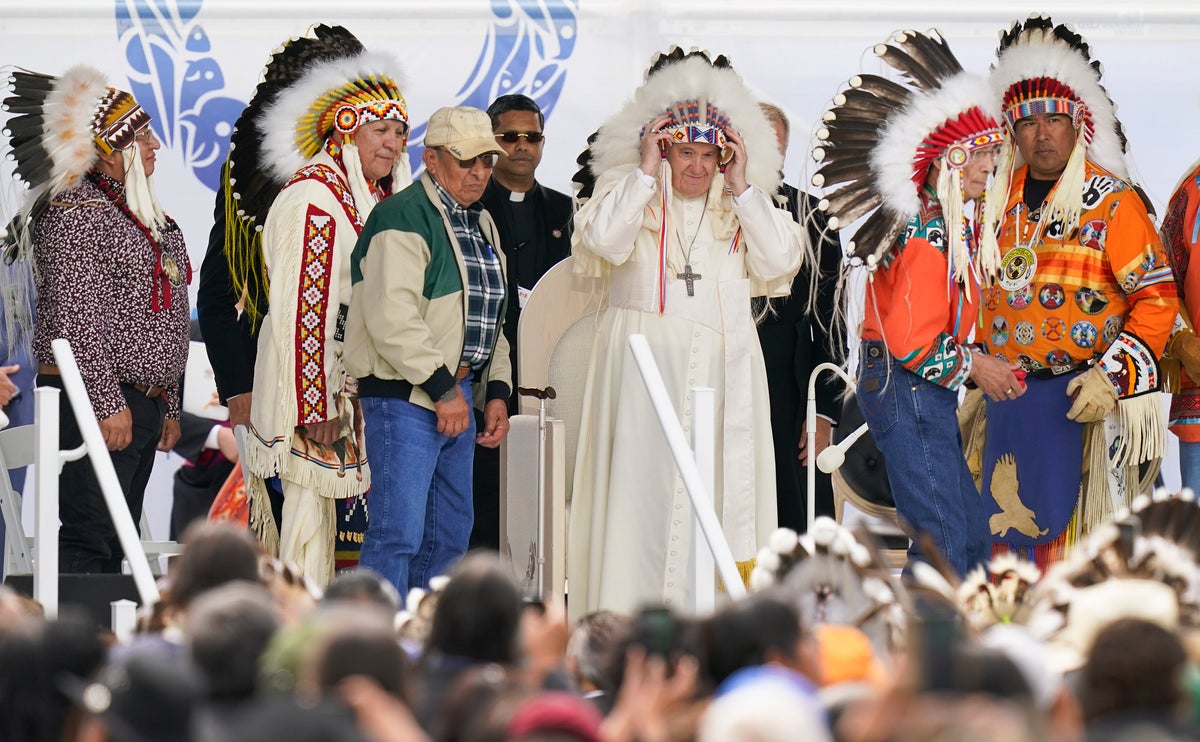
It was a stunning image: Pope Francis briefly donning a full Indigenous headdress, its rows of soft white feathers fastened in place by a colorful, beaded headband after he apologized for the Catholic Church’s role in Canada’s “disastrous” residential school system for Indigenous children.
Chief Wilton Littlechild, a residential school survivor himself, gave Francis the headdress Monday, placing it on his head amid cheering by an audience in Maskwacis, Alberta, that included many school survivors.
The Vatican and the pope clearly appreciated the gesture: Francis kissed Littlechild’s hands after receiving the headdress, something he has done in the past as a sign of respect for Holocaust survivors, and has done on this trip for residential school survivors.
The Vatican obviously understood the symbolic significance of the moment, putting the photo on the front page of the Vatican newspaper L’Osservatore Romano under the headline “I humbly beg forgiveness.”
Headdresses historically are a symbol of respect, worn by Native American war chiefs and warriors. For many Plains tribes, for example, each feather placed on a headdress has significance and had to be earned through an act of compassion or bravery. Some modern-day Native American leaders have been given war bonnets in ceremonies accompanied by prayers and songs.
Not everyone was pleased by Littlechild's action. Some members of Indigenous tribes said they found the gesture incongruous with the past transgressions at church-run schools that Francis apologized for.
Russ Diabo, a member of the Kahnawake Mohawk tribe in Canada and an Indigenous advocate and policy analyst, described the scene as “pageantry” and the pope's statements as “facile."
Diabo said on Twitter it was "the Catholic Church and Canada collaborating in creating a mythology for a shared ‘Reconciliation’ agenda narrated by prominent federal collaborators/residential school survivors!”
“I have so much to say about this, and all of it negative," tweeted Joe Horse Capture, vice president of native collections and curator of Native American History and Culture at the Autry Museum of the American West in Los Angeles.
"I am practicing ‘If you can’t say anything positive, don’t say anything at all’ mantra. But I’ll be honest, it’s difficult!,” added Horse Capture, a member of the A’aniiih Nation.
Maka Black Elk, executive director of Truth and Healing at Red Cloud Indian School in Pine Ridge, South Dakota, described the scene on Twitter as “a #toosoon moment.”
“The discourse around the #PopeFrancis headdress is unfortunate," wrote Black Elk. "He did not request that. It wasn’t his fault. But it’s also clear the givers did not consider how it would make other Indigenous people feel.”
Black Elk said later in a telephone interview that the mixed reaction to the headdress being placed on the pope's head “reflects the reality of native people and our need for more dialogue” about the past.
“I do think that Chief Littlechild felt it was important to honor this moment, and this was a significant moment,” he added.
A spokeswoman for Littlechild didn’t immediately respond Tuesday to a message seeking comment.
But Keeshon Littlechild used a Facebook post to defend his grandfather for giving Francis one of his own many headdresses.
“Bugs me to see people bashing my grandfather and I understand how much respect is needed to be gifted one but at the end of the day that was him showing the pope respect for coming all the way to maskwacis to apologize,” he wrote.
Jon Crier, a First Nations elder and residential schools survivor, said during a news conference after the apology that the gesture meant tribal leaders “adopted him as one of our leaders in the community.
"It’s an honoring of the man, it’s an honoring of the work he has done and it’s also recognizing … here’s a man that belongs in our tribe,” Crier said.
Marie-Anne Day Walker Pelletier, former chief of Okanese First Nation, told CTV, “I thought it was pretty cool. The chief of all chiefs now I guess.”
—-
Nicole Winfield and Peter Smith in Maskwacis, Alberta, and Rob Gillies in Toronto contributed reporting. Snow reported from Phoenix.
——
Associated Press religion coverage receives support through the AP’s collaboration with The Conversation US, with funding from Lilly Endowment Inc. The AP is solely responsible for this content.







